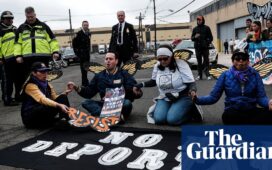Those who survive the perilous sea crossing between the Bahamas and the US describe a nightmarish odyssey of vomit, sweat and fear.
“It’s suicide – Russian roulette,” one Brazilian migrant recalled in a 2017 interview after at least a dozen fellow countrymen vanished while attempting the same illegal voyage across the Florida Straits.
Late last year, tears filled the eyes of one victim’s mother as she told the Guardian how her son had never made it back to their remote home in the Amazon after traveling to the Bahamas en route to the “American dream”.
Despite the dangers, people from countries as far apart as Cuba and China continue, with the help of with people smugglers, to use the islands as a springboard into the US – sometimes with devastating consequences.
On Wednesday search teams were scouring the shark-infested waters off Florida for any sign of the 39 people lost when their vessel capsized more than three days earlier. One body has been found.
The only known survivor, whose nationality was not revealed, told authorities the group had set off from the Bahamas’ Bimini island, 50 miles east of Miami, on Saturday night before encountering 9ft swells and 23-mph winds. None of the passengers were wearing life jackets.
Most of those taking the Bahamas route into the US hail from a trio of Caribbean countries. Between October 2020 and last September 838 Cubans, 1,521 Haitians and 742 Dominicans were apprehended by the US coast guard. Cuba is currently suffering its worst economic crisis since the 1990s and a political crackdown designed to quell a rare explosion of unrest, while Haiti, still recovering from 2010’s catastrophic earthquake, was thrown further into turmoil by another earthquake and its president’s assassination last year.
But a growing number South Americans are also reportedly using the route, among them Colombians, Ecuadorians and Brazilians, as well as East Asians. In January 2020 10 Chinese citizens were arrested trying to reach the US by boat, according to the Bahamian newspaper The Tribune.
In 2017 an official from Brazil’s foreign ministry said its nationals had been using the smuggling route – seen as preferable to the trek across cartel-controlled deserts and mountains in Mexico – for at least five years.
“[It’s] seen as being much safer and more comfortable. It doesn’t involve crossing a heavily monitored border on foot and so it has always been a very expensive route,” Luiza Lopes da Silva told the TV program Fantástico, which said coyotes charged up to 70,000 reais (£9,500) for the trip on a fishing boat.
The Brazilian survivor recalled feeling duped by the aquatic coyotes who spirited him across the Florida Straits, albeit successfully, under the cover of darkness. “My crossing was a nightmare. It was a small boat, the sea was choppy, there were storms. There wasn’t enough food or water,” the man complained of the 12-hour ordeal.
“When you’re in Brazil they promise you’ll be traveling in a top-notch vessel, like a yacht, with four people tops. But when you arrive they change everything. They send 15, 20, 30 people on a single boat, and won’t leave until they have enough people,” they added.
The Florida shipwreck is the latest humanitarian drama to expose the Covid-fuelled migration crisis gripping Latin America and the Caribbean, where the pandemic has killed more than 1.5 million people and wreaked economic havoc.
Last year more than 125,000, mostly Haitian migrants – among them elderly women and children – hiked through the Darién Gap, a snake-ridden jungle between Colombia and Panama, to reach the US after abandoning their homes in South America.
“God got us out of there,” said Edner Michel, a 38-year-old Haitian who recently braved the Darién with his wife and newborn child after leaving Brazil because of the crunch. “The feeling I had was that 95% of people who went in there would die.”
Meghan López, the International Rescue Committee’s vice president for Latin America, predicted the exodus would continue in 2022 as families sought to escape pre-existing crises such as poverty, hunger, violence and political turmoil that had often been exacerbated by Covid-19.
“These are crazy choices and yet they are not made by crazy people,” López said of their treacherous journeys. “They are made by desperate people making the very best decision that they can make in what are impossible conditions.”








